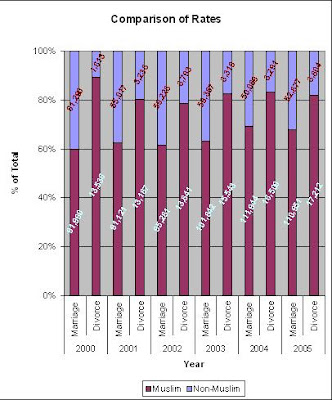How true is it though? Or more appropriately, does it apply to Malaysia?
Divorce as a topic has been in the news in the past few weeks. We have read about a growing concern about the local divorce rate. We discovered that one of the state governments has a small but successful program to sponsor a second honeymoon for couples thinking of heading to divorce. Based on the success of that program, they were considering expanding the program. Then we heard of another proposal for enrolling husbands in some sort of grooming course to better their appeal to their wives.
Strange and fantastic news indeed. So what feeds this fear on divorce rates? Is there some basis for this fear? Just how bad a beating is the institution of marriage suffering in Malaysia?
To do my research, I didn’t go for a primary source, such as the National Registration Department and/or Jabatan Kemajuan Islam Malaysia (JAKIM), although my source did rely on those two sources. After searching online, I found a paper researched by Samuel Chan Hsin Chien and Mohamed Sarif Mustaffa, for the Faculty of Education, University Technology Malaysia, Johor. The paper’s main purpose was to discover the situation of divorce in Malaysia.
From the two primary sources mentioned above, the authors of the research paper have obtained statistics on registered marriages and divorces amongst Muslims (from JAKIM) and Non-Muslims (from NRD) for the years 2000 to 2005, with a breakdown by state. The authors reached two conclusions from the data gathered.
First, although the divorce rate has grown moderately over the five year period from 9.88% to 12.83%, this is still small compared to some developed countries such as the US (51%, 1998), Australia (49%, 1996), Canada (48%, 1995), and Germany (44%, 1997). I don’t know the source of their statistics for those countries, but it does fit the standard notion that 1 in 2 marriages end in divorce. Unfortunately, those are also old statistics, so the situation may have changed now. No matter. It’s not the direction I’ll be looking at.
The second conclusion the authors reached is that the divorce rate amongst the Muslims is keeping proportionate to the increasing number of marriages, but the situation is not the same with the Non-Muslims. With the Non-Muslims, the number of marriages actually declined, while the number of divorces doubled. This led to an increasing divorce rate amongst the Non-Muslims, from 2.63% to 7.19%. Whether this is a trend that continued beyond 2005 and still continues today might be worth examining in detail. Nevertheless, the divorce rate amongst the Muslims is still significantly higher, increasing from 14.71% to 15.51%.

Playing around with the data, I came up with a graph comparing the split between Muslim/Non-Muslim marriages and divorces. It’s instructive to note that demographically, the ratio in the population is roughly 60%/40% Muslim/Non-Muslim. Looking back at the graph, it appears that a larger portion of Malaysia’s Muslim population is getting married as compared to the Non-Muslim population. Still, more than 80% of the divorces in the country were between Muslim couples. Although the gap between share of marriages and share of divorces is shrinking, that’s still about 15 points higher than the ratio of marriages between Muslims and Non-Muslims.

An interesting side story arises once we examine the data breakdown by state. Considering the average rate of divorce over the years examined, we discover that the top three worst states in descending order are Selangor, KL, and Penang, all with an average divorce rate above 15%. The three best states in ascending order are Sabah, Kedah, and Johor, incidentally the only states together with Sarawak and Negeri Sembilan with divorce rates below the national average of 11.55%. So Sabahans have the best marriages, and Selangorites have the worst? I’m not going to touch that topic with a ten foot pole.
So what do the authors make of this state of affairs? What are the major drivers of divorce in Malaysia? Unfortunately, the paper does not delve into this issue, but instead cites “numerous foreign literatures” (sic) as stating that the top three factors that influence divorce are “1) infidelity, 2) no longer in love, and 3) emotional problems.” It’s very likely that those factors are inter-related, and possibly so with other factors as well.
Are these the main factors that play a role in the Malaysian context? I don’t know. I have not located any research that studies this. But if they do, does that mean those state programs we read about recently are on the right track?
I should take this opportunity to note that I, too, am now a statistic. I join the ranks of the many faceless ones people always hear about. Those supposed sad cases, or scandals. Now I know, there is nothing to be either proud or ashamed about. It just is. Adjustments are made. Life goes on. And no, I’m not interested in participating in a survey. Not now at least.